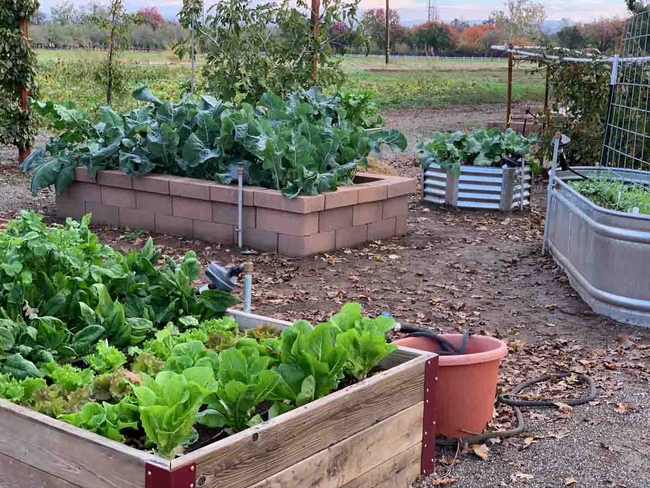The Covid pandemic accelerated a movement to backyard edible gardening that had been underway in this country since the mid-20th century. But the idea of the cultivated edible landscape goes back much farther, to the first colonists in the 1600s. These settlers brought seeds and cuttings of familiar plants with them on their voyages from Europe, introducing non-native fruit trees, vegetables, herbs, and bulbs to the colonies. Practicality and need dictated that home gardens were planted primarily with edible plants; often the most useful ones were grown right outside a door to the house.

The first Earth Day, in April of 1970, galvanized attention on the environment through teach-ins, rallies and marches across the U.S. Concern for the ecological relationship between humans and their physical surroundings began to become more mainstream. The use of chemical additives, pesticides, fungicides, and herbicides began to be questioned as the focus gradually started to shift towards more sustainable practices. And edible plants began to be introduced more often in garden landscaping.
If creating a garden that is visually interesting while providing food for you and your family and friends is one of your goals – where should you start?
Thoughtful Planning

While pulling out ornamental landscaping all at once isn't practical or economical for anyone, neither is moving forward without a plan. Going to the nursery or box store, purchasing trays of edibles, and introducing them into existing landscaping may create a haphazard-looking result that is not conducive to the needs of the individual plants. A thoughtful plan to reintroduce edibles into the garden is an important aspect of edible landscaping. Taking time to determine the requirements of particular garden plants and evaluating the characteristics of your own specific garden space will produce great dividends. Edibles don't need to replace ornamentals; both can live happily side-by-side, and some can do double duty – for instance, flowering fruit trees like pomegranate, peach, apricot and cherry produce beautiful spring blooms AND delicious fruit to eat.
Looking online or viewing various types of gardens in your local area is a first step in determining your personal likes and dislikes in both garden style and plant species. Keeping a notebook of your preferences is helpful: add photos you've taken of garden features or plants you admire; collect images from the internet or magazines. And you might visit the Master Gardeners Demonstration Garden at Patrick Ranch (10381 Midway in Durham, just south of Chico) to get some ideas from the Edible Landscape garden established there.
While looking at possibilities, keep in mind the physical traits of your property, like soil, climate, availability of water, and areas of sun and shade. Are there permanent features, such as paths, decks, patios, or fencing that will be incorporated into the new landscape design? What about trees? How will existing trees feature into the new plan? Once you have considered all these characteristics and parameters it is time to plan.
The Foundation

Amending the soil will likely be part of your preparations for an edible landscape. It is important to recognize the difference between soil amendments and fertilizers. Soil amendments do just what their name implies; they improve the soil and help build or improve its microbial community (bacteria, Actinomycetes, fungi, protozoa, nematodes). Fertilizers add nutrients. A distinction should be made between organic and chemical fertilizers. Organic fertilizers add complexity to the other soil amendments. Both organic and chemical fertilizers provide the important nutrients that plants need for good growth.
Creating an Edible Landscape

Of course, there is the fun of deciding what to plant: tomatoes, corn, peppers, green beans, herbs – ideally you can grow the kinds of vegetables and fruits you most like to eat.
If this is a DIY project, make sure you understand how to install irrigation or new planters and hardscape. Make sure underground utilities are marked before digging (you can arrange to have your utilities marked, at no charge, by calling 811). A mistake can be quite costly. When in doubt, hire a landscape contractor.
Plan for pollinators and other wildlife by including a small pond, or supply a birdbath as a focal point. Place a chair or chaise in a comfortable spot and enjoy the fruits of your labor…quite literally. There is always maintenance in a garden – feeding, mulching, pruning – but making the most out of your outdoor space and creating a sustainable edible oasis will provide years of enjoyment, healthy living, and fresh food that's easy to pick, right outside your door.
Local Nursery Crawl: Master Gardeners will be available to answer your gardening questions on Friday, February 24, 2023 from 9 am to 4 pm at Magnolia Gift and Garden at 1367 East Avenue, Chico during the Local Nursery Crawl. For more information on the Crawl and participating nurseries, see Local Nursery Crawl - Discover local nurseries and watch your garden grow!
UC Master Gardeners of Butte County are part of the University of California Cooperative Extension (UCCE) system. To learn more about us and our upcoming events, and for help with gardening in our area, visit our website. If you have a gardening question or problem, email the Hotline at mgbutte@ucanr.edu or leave a phone message on our Hotline at (530) 538-7201. To speak to a Master Gardener about a gardening issue, or to drop by the MG office during Hotline hours, see the most current information on our Ask Us section of our website.